Waging war in the Middle Ages
Military strategy
In the Middle Ages, with the exception of Crécy, Bouvines or Agincourt, there weren't really any major battles. The majority of military operations consist of avoiding pitched battles and open country confrontations. The majority of conflicts are only skirmishes or ambushes (however deadly), raids and relatively short operations but with relatively long movements due to the slow advance of the armies. Often, in local conflicts, it was a question of putting an adversary in difficulty by weakening him militarily (loss of men, equipment, etc.) and economically (demand for ransoms, destruction of resources). Thus, it was customary to engender fear and terror, which explains the sacks, looting and other rapines that most often affected poor and innocent populations.
The Battle of Crécy (1346)
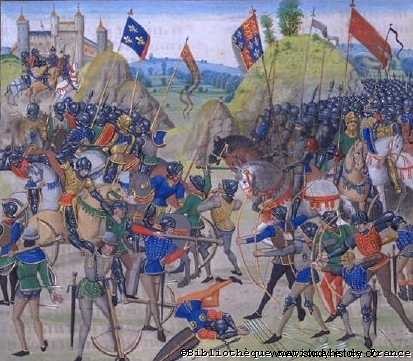
(National Library of France)
Military tactics
Most often, an army was a combination of horsemen and men on foot, which resulted in a rather complex device which was the work of great tacticians like Charles the Bold for example. It should not be forgotten that at the time, there were no staff maps. The commanders-in-chief had knowledge of the terrain only by employing spies or local guides. The use of maps only appeared during the 15th century for land operations, whereas they had been used since the 13th century for nautical expeditions.
The pitched battle
Denied most of the time, the pitched battle was however the highest point of any campaign. There are three types of fighters in battles:
- Mounted Cavalry :Consisting of 3 or 4 rows of horsemen forming a "battle ". The whole was made up of small tactical groups called "conrois » grouped around a banner representing a family or a lord. We then formed blocks of riders and spears as tight as possible. The horsemen moved slowly to maintain alignment, then accelerating as they approached the enemy. The goal was to disperse the enemy, to form isolated groups that were easy to defeat.
- The Dismounted Cavalry :The tactic was to wait for the opponent's attack. It could last a long time... It was widely used by the English, the French, for their part, did not appreciate it and used it much too late.
- Infantry :The infantry corps had three combat devices:in front line on a few ranks forming a sort of rampart; in a circle very common among the Swiss, employed by the French at Bouvines; en bloc like the battle in the form of a quadrilateral, to which is added a triangle of men facing the adversary. Such a formation of 10,000 men occupied an area of 60 by 60 m.
Sieges and strongholds
Seats
Most of the time, faced with the arrival of a massive army, the only solution adopted is to entrench oneself in a stronghold where we will organize ourselves to support the siege. The war of the time is therefore only a succession of loss and recovery of strongholds punctuated by dazzling charges of knights. If the attack failed, the surviving knights retreated again behind the walls of the stronghold. This is called the guerrilla war . The armies then engaged in an incredible game of chess which consisted in seizing strongholds, because whoever dominated them controlled the whole fief.
The siege of Orléans by Joan of Arc
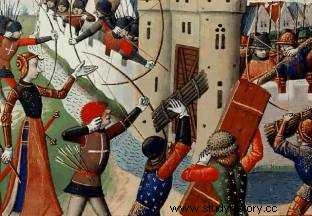
The castle
The castle is the place of residence of the lord, the more imposing it is and equipped with means of defense, the more the lord affirms his power and his glory. But it is also a military place protecting the goods and inhabitants of the fief. The first castles were wooden towers established on hills which were protected by several palisades and ditches. Vulnerable to fire and other throwing weapons, the stone was used at the behest of Normans. The first stone dungeons were square, later they were rounded to reduce blind spots. Then under the impetus of Philippe Auguste in France, the castles became veritable fortresses. It then became difficult to seize it. The most common method was the seat , the castle was surrounded to cut it off from resources. Lacking supplies, the besieged ended up surrendering. However the castle could contain a large amount of resources and the siege could last for years. It was then necessary to proceed to the capture of the castle.
See the interactive description of a fortified castle
The army corps
Cavalry
Usually there were three cavalry divisions, the first wave was to drive the enemy in, hamper and scatter them, so that the next two waves could rout them. The knights, who were the elite of the army rarely obeyed orders, they fought only for their personal glory, victory was only in the background. Sometimes, the strategists put their riders on foot to fight with the infantry as reinforcements, we placed ourselves behind devices (piles, trenches) to counter charges. The battle of Crécy (1346) shows the indiscipline of the knights, the French who were much more numerous came up against the English archers who took refuge behind stakes, they were supported by knights on foot, and defeated the French. But at the end of the Middle Ages, the role of heavy cavalry was much reduced, the strategists had understood that it was not enough to charge well disciplined infantry troops. Devastating charges were still possible, but when the enemy was fleeing and disorganized.
The archers
During the Middle Ages, there were all kinds of throwing weapons (short bow, long bow, crossbow), the advantage of archers was to be able to kill the enemy without engaging in individual combat. Very practiced in ancient times, the throwing weapon was forgotten at the beginning of the Middle Ages when the knights dominated the territories. The honor code rejected the bow, which is considered a coward's weapon. But the archers remained useful for sieges and battles, they were decisive during the battles of Hastings (1066) and Crécy (1346). The archers were in close formation, their arrows could pierce armor within a hundred yards. The English used archers a lot because they were at a disadvantage when fighting off their island. They developed the tactic of barrage fire, rather than aiming at an individual target, they aimed at the area occupied by the enemy. They could also shoot six arrows per minute. The crossbowmen became essential in the other armies of Europe, which profit from a better precision. Around the 14th century, the first handguns appeared on the battlefields.
The Battle of Hastings (1066)

Episode from the Bayeux Tapestry
Infantry
During the Dark Ages, the infantry were predominant in the armies, the tactics were simple, one approached the enemy and gave him great blows with the swords. The Franks threw their axes before rushing at the enemy to break their ranks. The arrival of the knights eclipsed the infantry, which lacked discipline and training, it was often a militia of peasants. The Saxons and Vikings used their shields forward to protect themselves from archers and horsemen. The hilly countries (Scotland, Switzerland) learned to use the infantry against the enemy, the spearmen and pikemen armed with spears and points could thus rout a cavalry. The Scots placed a ring of lancers during their wars of independence (like in the movie "Braveheart"). The Swiss specialized with the use of pikes by re-adapting the Greek phalanx formations. To counter these tight heavy formations, the Spaniards had the idea of using artillery, then charged with infantry equipped with small arms.
The information below is taken from the site www.donjons-de-france.com which we thank for its cooperation.
Armor
Soldier's armor
Very quickly, it was understood that defending oneself from combat was as important as striking the enemy. The term "armour" only appeared in the 15th century to designate steel protections, previously we spoke of harnois or knight . The first armors were made of leather, the Greeks and Romans used bronze. With the fall of the empire, the armor disappeared, the barbarians carried only a shield and a helmet. In the Carolingian period, armor reappeared, pieces of metal (scales, rectangles, rings) were placed on a large fabric, it is the broigne , used by the Carolingians and Normans. In the 12th century, the hauberk was adopted (chainmail), real metal fabric. A mail hood and leather gloves sometimes completed the equipment. Then, in the 13th century, the coat of mail was completed with gauntlets and chainmail breeches, then iron pieces were added, because the hauberk was vulnerable to shock weapons (mace, hammer). Then arms, torso, elbows, legs were in turn protected. In the 14th century, there was a transition from chain mail to full plate armour, before being abandoned by the appearance of firearms.
| 12th century - Long mail hauberk, conical to nasal helmet | 13th century - Chain mail completed with breeches and gauntlets, surcoat, cylindrical helmet | 14th century - Gambeson and hauberk, surcot, elbow pads, knee pads and greaves | 15th century - Full plate armour, mail gorget and bascinet |
|---|---|---|---|
 | 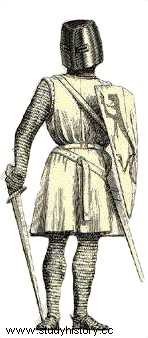 |  | 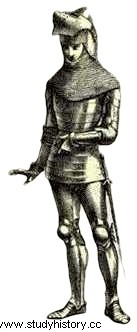 |
The helm
The helmet designates head armor, the term appeared in the 12th century, the use of the helmet however dates back to antiquity. The successive improvements of the helmet consisted in covering more and more the face making it difficult to identify its owner. This is perhaps the origin of Heraldry, the science of coats of arms. A very famous episode appears in the Bayeux tapestry, William the Conqueror takes off his helmet to be recognized by his men who thought he was dead. In the 10th century, the conical helmet with nose protection was used, which was imported by the Normans. From the 13th century, to better protect the face, a cylindrical helm was created enveloping the entire head with slits only for the eyes. These helms were heavy and made breathing difficult. Improved iron working techniques allowed a return to a conical shape on top of the helm which provided more protection than the flat shape, while still retaining face protection. The bassinet, which appeared around the beginning of the 14th century, considerably improved comfort. It was less heavy and had a visor that could be raised. At the end of the 14th century, the "toad's head" helmet made its appearance (used during tournaments and jousting ).
| Conical helmet with nasal protection (11th century) | Flat-topped cylindrical helm (12th century) | Helmet with bascinet (12th century) | "Toad's head" helm (14th century) |
|---|---|---|---|
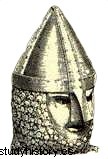 | 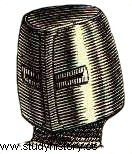 | 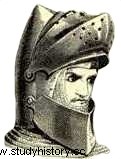 |  |
The shield
The shield is the most common and ancient defense weapon, spontaneously, men used pieces of wood to ward off blows. Then we installed fasteners intended to maintain the shield with one hand, sometimes we added a strap to rest the shield on the back in order to handle heavy weapons. The first shields were round, but it was the Romans who adopted shields with straight edges, which were much more effective against projectiles. But in the Middle Ages, the Franks and the Vikings used rather round shields covered with leather for better rigidity. We call shield, the shield of the Middle Ages. From the 11th century, the Normans adopted the long shield, rounded on the top, and extending to protect the legs. Improved armor and the use of horses forced soldiers to use a smaller shield. From the 13th century, the shield regularly bears the coat of arms of its owner, which makes it possible to identify it. In the 14th century, the smaller tournament shield appeared, it had a notch on the top to hold the spear. The bulwark also made its appearance, it was a large oval shield carried by infantry and crossbowmen, who planted it in the ground to protect themselves when reloading their weapons.
| Vicking shield with the umbo in the center | 11th century Norman shield | 13th century V-shaped shield |
|---|---|---|
 |  |  |
Weapons
Melee weapons
- The Sword :It is the weapon most used by the man-at-arms of the Middle Ages. The Carolingian era sees the long sword settle (the Romans used short swords). It then became a noble weapon and the knight sometimes gave it a name (Durandal, Roland's sword). At the end of the 12th century, the handle became longer to be carried with two hands. There are two types of swords, light and heavy blades used to thrust or size (point or edge), knights often possessed both types of blade.
- The spear :It is a very old weapon, one uses a long stick equipped with an iron point. In the 11th century, the spear did not exceed three meters, it was used to charge the enemy. A steel hilt was added to protect the knight's hand. In the 14th century, a hook was used fixed on the armor so that the knight could hold the spear under the armpit. The spear was thus longer and heavier.
- The Scourge :It is a wooden handle fitted with a metal chain on which is hung an iron mass, the French used it very little. It was particularly destructive for the hauberks, it was then lengthened, to reach the riders. The mace was generally spherical and armed with spikes. A variation of the flail:the bottle brush had several chains topped with sharp-pointed balls.
- The Axe :The Germanic tribes were the first to use the ax (tool) in combat. The Franks used the francisque (short single-bladed axe), which they could throw 3-4 meters to open the fight. They later used the Danish ax, long (1m50) held with two hands. In the 14th century, new axes appeared (halberd), which could strike size and throwing (cutting edge and tip).
- Mass :Composed of a handle and a head furnished with spikes, it has been used since the 12th century. The mace could shatter a skull or even snap a limb through the hauberk. Later, the mace was formed from a series of blades, the handle was made of iron to prevent it from breaking.
| The Scourge | The Ax | Mass | The Franciscan Ax |
|---|---|---|---|
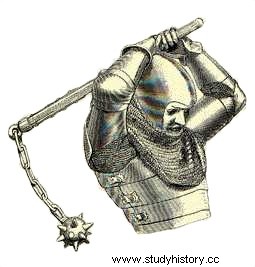 |  |  |  |
Throwing weapons
- The Bow :Weapon dating from the Neolithic era, it is a curved wooden stick with a rope tied at the ends. The composite bow was a major advance, improved at the level of the horn and the nerves. Arrows had to have a stable trajectory to be effective, generally inexpensive, they were produced in quantity. The size of the arrows depended on how difficult it was to bend the bow. The archer was dressed lightly to be able to move more easily, for his survival, he had to have an additional weapon (knife, sword).
- The crossbow :This weapon derives from the bow, it is used from the tenth century. The bow is placed on a piece of wood that holds it (arbrier ) and a mechanism (nuts ) which keeps the string taut, lets go of the arrow, and draws the bow. The crossbow is more powerful and precise than the bow but its cadence is lower. The short arrows were called bolts (15 to 30 cm). Pope Innocent II banned the use of this instrument in 1139 (which is said to have been invented by the devil), but it was used against the infidels during the Third Crusade. The different crossbows are characterized by their mechanism:
- The Fanged Crossbow :while holding the crossbow with both hands, the soldier engaged his foot in a stirrup and stretched the rope by pushing the weapon.
- Crowbar crossbow :made up of a lever with two branches, when it was tilted, it brought back two hooks towards the back which bent the arc. It was used a lot by mounted crossbowmen.
- The muffle crossbow :a rope attached to a winch was placed using a hook on the soldier's belt, which by pulling on it lowered the winch and bent the bow, it is the most powerful of crossbows.
- The Cranequin Crossbow :made up of a rotating drum which, under the effect of a crank, moved on a toothed rack wheel. A Chinese strategist invented in the 3rd century a repeating crossbow that could fire ten bolts in fifteen seconds.
| Archer | Crossbowman |
|---|---|
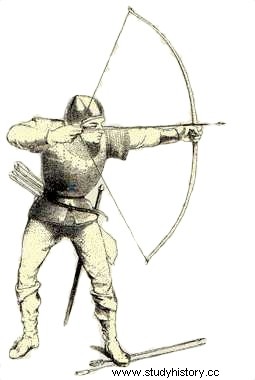 | 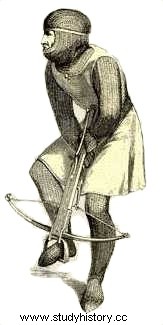 |
